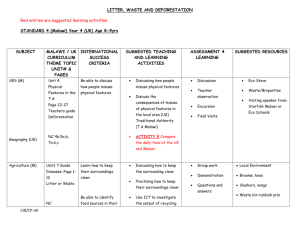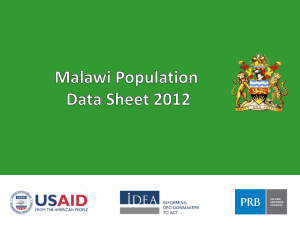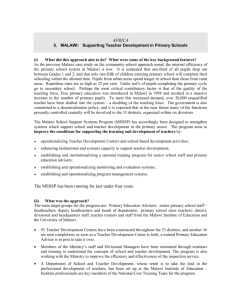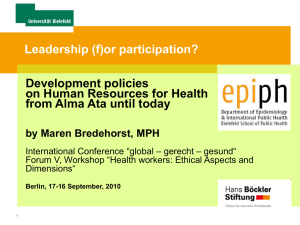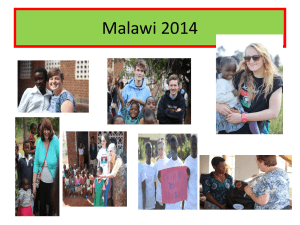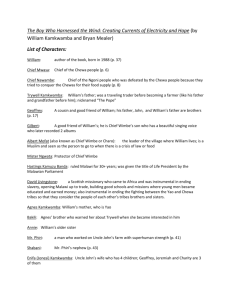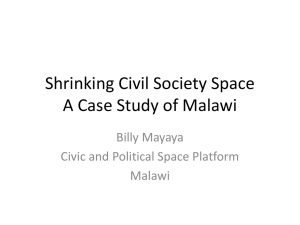Stephanie Smith - Furman University
advertisement
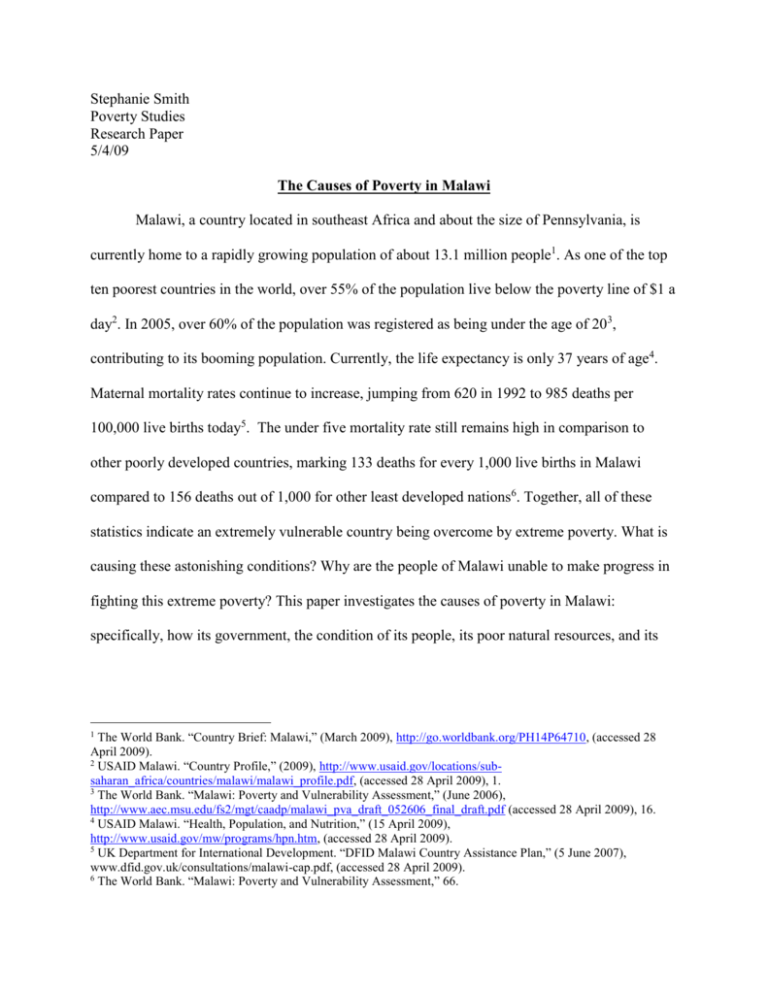
Stephanie Smith Poverty Studies Research Paper 5/4/09 The Causes of Poverty in Malawi Malawi, a country located in southeast Africa and about the size of Pennsylvania, is currently home to a rapidly growing population of about 13.1 million people1. As one of the top ten poorest countries in the world, over 55% of the population live below the poverty line of $1 a day2. In 2005, over 60% of the population was registered as being under the age of 203, contributing to its booming population. Currently, the life expectancy is only 37 years of age4. Maternal mortality rates continue to increase, jumping from 620 in 1992 to 985 deaths per 100,000 live births today5. The under five mortality rate still remains high in comparison to other poorly developed countries, marking 133 deaths for every 1,000 live births in Malawi compared to 156 deaths out of 1,000 for other least developed nations6. Together, all of these statistics indicate an extremely vulnerable country being overcome by extreme poverty. What is causing these astonishing conditions? Why are the people of Malawi unable to make progress in fighting this extreme poverty? This paper investigates the causes of poverty in Malawi: specifically, how its government, the condition of its people, its poor natural resources, and its The World Bank. “Country Brief: Malawi,” (March 2009), http://go.worldbank.org/PH14P64710, (accessed 28 April 2009). 2 USAID Malawi. “Country Profile,” (2009), http://www.usaid.gov/locations/subsaharan_africa/countries/malawi/malawi_profile.pdf, (accessed 28 April 2009), 1. 3 The World Bank. “Malawi: Poverty and Vulnerability Assessment,” (June 2006), http://www.aec.msu.edu/fs2/mgt/caadp/malawi_pva_draft_052606_final_draft.pdf (accessed 28 April 2009), 16. 4 USAID Malawi. “Health, Population, and Nutrition,” (15 April 2009), http://www.usaid.gov/mw/programs/hpn.htm, (accessed 28 April 2009). 5 UK Department for International Development. “DFID Malawi Country Assistance Plan,” (5 June 2007), www.dfid.gov.uk/consultations/malawi-cap.pdf, (accessed 28 April 2009). 6 The World Bank. “Malawi: Poverty and Vulnerability Assessment,” 66. 1 Smith 2 failing economy contribute to impoverished conditions, trapping the country in a cycle of poverty it cannot escape. In order to understand the context of poverty in Malawi it is necessary to understand the history behind the country. Malawi’s history dates back to the late 1400’s, when Bantu-speaking natives established the Maravi Confederacy near Lake Nyasa (known today as Lake Malawi). This region remained under Maravi control until the arrival of slavery and Arab traders in the mid-nineteenth century. David Livingstone, a Scottish Presbyterian missionary, arrived at Lake Nyasa in 1858. After his arrival the Scottish church began establishing missions with the goal of ending slavery, Livingstone being a key player in this fight. In 1876 the city of Blantyre was established in the southern region as slavery-fighting headquarters and in 1878 the African Lakes Company was founded to help supply necessities to the missionaries in Malawi. In 1881 a British consul was appointed to help smooth disagreements between slave traders and missionaries. In 1893 the region was established as a British protectorate and was named Nyasaland in 1907. For several decades after its establishment Nyasaland struggled to survive economically. Consequently, in the early 1950’s it almost joined with Rhodesia (Zimbabwe) and Northern Rhodesia (Zambia) to form one nation. To preserve each country’s independence however, in 1953 an agreement, named the Federation of Rhodesia and Nyasaland, was made in hopes of “deriv[ing] the greatest economic benefit from the larger unit while minimizing political tension between the three parts of the federation, each of which retains its existing local government”7. Nothing monumental arose from this Federation and by the early 1960’s African politicians Bamber Gascoigne. “History of Malawi,” History World, (2001, ongoing), http://www.historyworld.net/wrldhis/PlainTextHistories.asp?historyid=ad48#3377, (accessed 17 April 2009). 7 Smith 3 began gaining more power within their local governments. In 1963 the Federation finally broke up after many protests from Rhodesia, Northern Rhodesia, and Nyasaland8. In 1958 Dr. Hastings Kamuzu Banda returned to Nyasaland from extended travel to Nashville, Tennessee, where he attended and graduated from Meharry Medical College, before practicing medicine in England and Ghana9. When he returned he became much more politically active, assuming the role of president of the Nyasaland African Congress (NAC), which later became the Malawi Congress Party (MCP). In 1963 Nyasaland was granted the self-governing status shortly before the Federation dissolved, and Banda became the prime minister. On July 6, 1964 Nyasaland became an independent nation and was renamed Malawi, while Banda still remained prime minister. Many of the reasons behind decisions Banda made during his rule were unidentifiable. For this reason Banda lost many of his cabinet members early on in his reign. His cabinet members were from “the younger, educated section of the community, and were suspicious of localized traditional authority, which had been supported by the colonialists”10. They were also more able to examine the past and see through Banda’s unfair decisions. Most of Banda’s support came from those with “no schooling beyond primary level, who were more likely to look uncritically at the past”11. Banda declared Malawi as a republic and himself as president in 1966, and then declared himself president for life in 197112. Banda’s time in power as president for life has been viewed as extremely exploitive. Facing his critics, he even “admitted to being a dictator, but he saw this as not inconsistent with democratic values”13. He Bamber Gascoigne. “History of Malawi”. Bureau of African Affairs. “Background Note: Malawi,” (March 2009), http://www.state.gov/r/pa/ei/bgn/7231.htm, (Accessed 18 April 2009). 10 Peter Forster. “Law and Society under a Democratic Dictatorship: Dr. Banda and Malawi,” Department of Sociology and Anthropology, School of Comparative and Applied Social Sciences, The University, England, Koninklijke Brill NV: Leiden, 2001, p. 276. 11 ibid 276. 12 Bamber Gascoigne. “History of Malawi”. 13 Forster, Peter. “Law and Society,” p. 276. 8 9 Smith 4 explained that since Malawi was “distinctive culturally” a different, more well suited form of “democracy” was necessary to cater to the Malawian people, and that it would not follow “Western models”14. He argued that although he was a dictator, that he “dictated by consent”, and that it was the “democratic will of the people to have a dictator”15. Banda justified his rule and the power he held by rooting it in tradition. He especially valued the “good village” concept. This concept explained that in a “good village” the “headman and elders were respected by all, and they too had regard for all; the young respect parents and no one tries to harm another”16. In the eyes of Banda, Malawi was his “good village” and he was the headman. His villagers “may not live up to [his] standards but must never rebel against them”. Banda was always quick to reprimand anyone whose views or opinions opposed his own. Central to the causes and perpetuation of poverty in Malawi was its government. Malawi continued to run under Banda’s one-party dictatorship until the early 1990’s when “increasing domestic unrest and pressure from Malawian churches and from the international community led to a referendum in which the Malawian people were asked to vote for either a multi-party democracy or the continuation of a one-party state”17. On June 14, 1993 a vote was held to determine whether Malawi would continue to run under a one-party state or whether there would be a transition to a multi-party democracy. The Malawian population voted and a multi-party democracy became the unanimous victor. On May 17, 1994 the first democratic elections were held with Bakili Muluzi and Chakufwa Chihana running against former president-for-life Banda18. Bakili Muluzi, former cabinet member under Banda and president of the United Democratic Front, decisively won the election ending Banda’s thirty year reign shortly. Muluzi 14 ibid 276. ibid 277. 16 ibid 277. 17 Bureau of African Affairs “Background Note”. 18 “Dictator Said to be Trailing in Malawi’s First Open Election,” (19 May 1994), New York Times, p. A8. 15 Smith 5 instituted a new democratic constitution in 1995 bringing great freedom to Malawi19. In an interview after his election when asked “what [did] he think [he had] achieved in [his] first 100 days in office”, Muluzi commented that “People [are] now able to smile and live without fear. The human liberty of a person is most important. This has been lacking for over 30 years”20. Muluzi sought to improve relations between Malawi and other foreign countries, especially Arab countries, which Banda had neglected. His main campaign though, which he struggled to accomplish, was to reduce food shortages and the number of people living in poverty, while eliminating governmental corruption. In 1999, Muluzi was reelected to a second five-year term. Muluzi’s second term was much more controversial than his first, as it included the famine of 2002. During the famine, which was rooted in the underproduction of maize in 2001 due to flooding, maize prices increased 340% almost overnight21. Estimates about the total number of deaths due to the famine tallied around 1,000-3,000 deaths22. There were also suspicions about corrupt governmental actions in selling all of the maize reserves and pocketing the money for personal gain, but there was no conclusive evidence to make any accusations23. Muluzi finished out his second term unable to make a last-ditch effort to extend his term by amending “the constitution to allow further terms”24. In 2002, Bingu Wa Mutharika defeated John Tembo and Gwanda Chakuamba and took office as second UDF president25. He immediately embarked on a mission to eliminate any remaining government corruption and to make government spending for Encyclopedia Britannica Online. “Malawi,” (2009), http://www.britannica.com/EBchecked/topic/359614/Malawi (accessed April 28, 2009). 20 Africa Report. “Interview of President Muluzi by African Report,” (1994), EBSCOhost, (accessed 28 April 2009). 21 Oliver Ruben. “The Malawi 2002 Famine-Destitution, Democracy and Donors,” Nordic Journal of African Studies, 17(1), (2008): 49-50. 22 ibid 23 Encyclopedia Britannica Online. “Malawi”. 24 ibid 25 Bureau of African Affairs “Background Note”. 19 Smith 6 efficient so that the government would run much more smoothly26. In 2005, Mutharika left the UDF party because of differing interests and founded the Democratic Progressive Party (DPP). The election of Mutharika and his first term marked a turning point in the country’s leadership, in that Mutharika so far has not been as corrupt a leader as was Banda and Muluzi. Malawi’s history of corrupt political leadership has helped to feed the growth of poverty in the country, and only time will tell whether Mutharika will be able to break free of this corruption or succumb to it himself. The next election to be held in Malawi is on May 19, 2009. Crucial to understanding the causes of poverty in Malawi, is also understanding the condition of Malawi’s people, in particular the effects that lack of food and nutrition, the HIV/AIDS epidemic, and poor educational systems have had on their lives. The food supply in Malawi has always been problematic, as subsistence farming provides the country with its staple food maize. The maize that each family grows, on their own small plot of land, is the food that must feed them the entire year. It rarely does. Most years Malawi endures a “food shortage during the so-called hungry months, December and March, the single growing season”27 where families are lucky if they eat one small meal a day. According to a report made in 2005 by the United Kingdom’s Department for International Development only 22.3% of the population is able to meet its basic food requirements28. As a result, malnutrition runs rampant through Malawi, having its greatest effects on the children. In 2007 a study found in comparison to normal children height-to-weight growth charts that 48% of children in Malawi under five years of age are “stunted (too short for their age)”, 22% are “severely stunted”, 5% are “wasted (too Encyclopedia Britannica Online. “Malawi”. Barry Bearak. “Why People Starve,” (New York Times, 13 July 2003), http://www.nytimes.com, (accessed 28 April 2009) 28 UK DFID. “DFID Malawi”. 26 27 Smith 7 thin)”, and 22% are underweight29. Not only are the people of Malawi not receiving enough food on a daily basis but they also do not receive a wide variety of nutrients. Since the staple food, nsima, is made from maize the main nutrient the population receives is starch. Another common dish that accompanies nsima is relish, made up of a cooked wild type of cabbage. The cabbage must be cooked well in order to kill the bacteria living in the water in which the cabbage was washed. Unfortunately, though, the longer the cabbage is cooked the less nutrients that remain in it. Also, it is very rare for a family’s meal to consist of any type of protein, like chicken or beans, or any type of fruit. This leaves the people lacking in iron, vitamin A, and zinc30. Insufficient amounts of these important nutrients in children can lead to mental and cognitive disabilities. Children that do not develop properly “become adults with lower intellectual and physical abilities”31. In Malawi, without proper amounts of food and the essential nutrients “people may actually find it impossible to build the necessary human, physical and social capital (or assets) that would enable them to raise their welfare level on a sustainable basis” perpetuating the cycle of poverty32. Just as insufficient food conditions in Malawi have drastically affected the abilities of the people, the HIV/AIDS epidemic, which is spreading at alarming rates, has had catastrophic effects on the familial structure, and in particular the middle generation expected to provide for the family. Malawi’s first reported case of AIDS occurred in 198533. Despite early attempts to prevent the spread of HIV/AIDS, progress while under President Banda’s rule proved to be very difficult. Banda considered discussing AIDS and HIV “taboo”, making it impossible to educate The World Bank. “Malawi: Poverty and Vulnerability Assessment,” 70. Natalie Dickinson, Gordon Macpherson, Andrew S. Hursthouse, & John Atkinson. “Micronutrient Deficiencies in Maternity and Child Health: A Review of Environmental and Social Context and Implications for Malawi,” Enviorn Geochem Health, 31 (2009): 256. 31 ibid 253. 32 The World Bank. “Malawi: Poverty and Vulnerability Assessment,” 132. 33 Graham Pembrey. “HIV & AIDS in Malawi,” (February 2009), http://www.avert.org/aids-malawi.htm (accessed 28 April 2009). 29 30 Smith 8 the public about the disease thereby helping to curb its spread. Between the years 1985 and 1993, during Banda’s rule, the percentage of women tested for HIV during prenatal doctor visits jumped from 2% to an alarming 30%34. After Muluzi took office and instituted many new policies attempting to reverse the damage Banda caused, the rate at which the disease is spreading seems to be stabilizing. Despite the apparent stabilization between 1998 and 2005 the number of newly infected people jumped from 52,643 to 96,552 respectively, making the making the war against this epidemic still very urgent35. In 2005 there was a 14% occurrence rate of HIV in adults between the ages of 15-4936. Today there are close to 1 million people living with AIDS and it is the leading cause of death in adults. One in every eight people dies every hour from the disease37. The epidemic is having catastrophic effects on the familial structure, causing a cultural restructuring of the family unit. Within the developmental stages of life, individuals are the most dependent during their early childhood years and towards the end of their lives as old age approaches. This poses an enormous problem, as the main group targeted by HIV/AIDS is the middle generation, adults between the ages of 15-49. This generation is relied on most to produce for the economy and provide for their families (especially the young and old)38. As this age group is wiped out by HIV/AIDS, there has been a shift from a typical nuclear family structure, one consisting of solely a mother, father, and children, to one that extends to include distant relatives and sometimes, unrelated friends, trying to care for orphans. In Malawi in 2007 there were about 560,000 children registered as being an orphan, losing one or both parents, due 34 ibid UNDAF Malawi. “United Nations Development Assistance Framework 2008-2011,” (2008), http://www.unmalawi.org/reports/undaf/undaf_malawi_2008-2011.pdf (accessed 28 April 2009). 36 UNAIDS and World Health Organization. “2007 AIDS Epidemic Update: Sub-Saharan Africa,” http://data.unaids.org/pub/Report/2008/jc1526_epibriefs_ssafrica_en.pdf (accessed 28 April 2009). 37 Graham Pembrey. “HIV & AIDS in Malawi”. 38 Mike Mathambo Mtika, “Family Transfers in a Subsistence Economy and under a High Incidence of HIV/AIDS: The Case of Rural Malawi,” Journal of Contemporary African Studies 21,1 (2003): 69-92. 35 Smith 9 to the AIDS epidemic39. As parents are dying of AIDS leaving children orphaned, they are forced to find other places to live. They are often taken in by aunts and uncles or other distant relatives and incorporated into their families. However, when taken in by these families frequently they are treated harshly, due to the taboo of being an AIDS orphan (despite being family) and because they are an extra mouth to feed. The hierarchical structure that establishes who holds the most power and status, and therefore who runs the household, is also changing in Malawi. As the middle generation continues to die off, responsibility is falling back onto the elderly generation who are not fully capable to perform the necessary day-to-day tasks required to run a household. The elderly’s frail and deteriorating health makes farming, cleaning, cooking, and caring for children an almost impossible task40. Children also are forced to bear huge responsibilities. They often are the primary caregivers for parents when they are sick, and upon death, if there are no relatives available to take in the children, a child-headed household arises. Child-headed households are becoming increasingly more common. With the middle generation being eliminated so rapidly, it is extremely difficult to make any progress economically with the hope of escaping poverty. Malawi also faces a crisis in its educational system. Due to a lack of qualified teachers, poor building conditions, and poor access, Malawi’s educational system is failing to meet the needs of Malawi’s children, and thereby helping them improve their own welfare situations. Prior to 1994, the educational system of Malawi was very neglected by the government. There were very few public government schools throughout the country, making education, especially Graham Pembrey. “HIV & AIDS in Malawi”. Vuyiswa Mathambo, Andy Gibbs, Linda Richter, & Lorraine Sherr. “Qualitative Accounts of Family and Household Changes in Response to the Effects of HIV and AIDS: A Review with Pointers to Action,” Joint Learning Initiative on Children and HIV/AIDS, (31 August 2008), http://www.jlica.org/userfiles/file/Mathambo%20&%20Gibbs%20Qualitative%20accounts%20of%20family%20an d%20househol.pdf, (accessed 28 April 2009). 39 40 Smith 10 for village children, impossible unless there was a mission school nearby. Enrollment of children ages 6-13 was 43% in 1980 and only 55% in199241. In 1994, President Muluzi, upon his election to office, instituted Free Primary Education (FPE) for all Malawian children. With the creation of this new policy enrollment levels jumped from 1.3 million children in 1993 to over 3 million children in 2004, an increase of over 100% enrollment42. The majority of this increase in students was identified as female. It was no longer justified to only pay for boys to go to school since school was now free, so prejudices against girls attending school dramatically decreased. Today there are still over 3 million children enrolled in primary school with about an 80% enrollment rate43. Although the new policy seemed promising, it has brought many new problems to the educational system. Now, instead of an insufficient number of children being enrolled in school, there are too many and not enough resources to provide a quality education for all students. Since the induction of the FPE policy hundreds of new governmental schools were built but there are still not enough to accommodate all students currently enrolled. Today there are “5,307 primary schools in Malawi for 3 million children” which calculates to over 565 students on average per school44. Students on average must walk at least 2 kilometers to get to and from the closest school everyday45. Once the children arrive at school they are then faced with an inadequate supply of resources to properly house all of them. Most schools do not have enough classrooms for all of their students and numerous classes must be held outside under the shade of trees. Sitting outside however sometimes proves to be better than the conditions inside the buildings whose structures are deteriorating rapidly. Massive potholes or crumbling walls are Dr. Ken Lipenga. “Improving Quality of Education,” The Commonwealth Advanced Seminar, (2004), http://www.victoria.ac.nz/commonwealthseminar/Papers.aspx#c04, (accessed 2 May 2009), 1. 42 Ibid 1 43 UK DFID. “DFID Malawi”. 44 Dr. Ken Lipenga. “Improving Quality of Education,” 3. 45 USAID Malawi. “Education,” (15 April 2009), http://www.usaid.gov/mw/programs/edu.htm, (accessed 28 April 2009). 41 Smith 11 not uncommon within classrooms, while children arrange themselves to avoid these obstacles. Classrooms also lack the materials needed to properly facilitate learning. It is not abnormal to walk into a classroom and find it completely empty, or just housing one small chalkboard, as “only 20% of pupils have access to desks and chairs”46. In the classrooms that do contain small desks, multiple students must squish to share working space. There are rarely ever textbooks for the students, and paper notebooks and pencils are passed around classrooms and shared by students. Within the primary school system only 26% of the students complete primary school47 with half dropping out before their fifth year48. After graduating from primary school a select few, 40%, choose to continue their education in secondary school. Secondary school is not free so the majority of the students come from the wealthier backgrounds in Malawi49. Perhaps the biggest problem within the educational systems though, is the lack of qualified teachers. In primary schools the student teacher ratio is 84 to 150. It is very difficult to attract new qualified teachers to rural villages where running water and electricity are not available. With such poor educational systems, Malawi’s people are left ill-equipped to provide for themselves and escape the cycle of poverty. Malawi currently ranks 162 out of 179 on the UN’s Human Development Index, which measures the health, longevity, education, and standard of living of a country. The inabilities of the Malawian population to work to provide economically for themselves has been seriously compromised by their lack of nutrition and food, the HIV/AIDS epidemic which eliminates the middle generation, and the deprived governmental school systems making it almost impossible to make any strides toward breaking away from impoverished conditions. UK DFID. “DFID Malawi”. UNDAF Malawi. “United Nations Development Assistance Framework 2008-2011”. 48 UK DFID. “DFID Malawi”. 49 USAID Malawi. “Education”. 50 UK DFID. “DFID Malawi”. 46 47 Smith 12 Poverty in Malawi is also rooted deeply in the condition of the country’s land, in particular its climate, the condition of its water supply, and its natural resources. Geographically, Malawi is a landlocked country located within the Great Rift Valley. Lake Malawi, located on the eastern side of the country, makes up 20% of the country’s total area51. Malawi is scattered with plateaus (2500-4500ft above sea level) in the central region, highlands (8000ft) in the north and west, and mountains (peak around 10,000 ft) in the south. With a subtropical climate, there are two main seasons in Malawi the wet season, November through April, and the dry season, May through October52. The country is extremely vulnerable to any great changes in climate, especially drought, as the “majority of the population relies on rain-fed farming for their income”53. Rainfall levels vary greatly from year to year. Rain stations set up around the country in divided areas by the World Bank measure these levels and account for droughts in each area. A drought is defined as having a “cumulative rainfall which is below 75 percent of the long-term average”54. According to the measurements made by the 22 different weather stations, between 1996 and 2005, 5 out of the 10 years (1996, 1997, 2000, 2004, 2005) there was a drought in at least 1 out of the 22 areas. In 2000, 2004, and 2005, there was a drought in 8 out of the 22 areas55. These inconsistencies in rainfall greatly affect the growth of crops throughout the year, especially maize. The inconsistencies in crop growth then greatly affects the amounts of food Malawian families have for the year. Malawi has also struggled with “land degradation” as the population continues to grow rapidly and subsistence farming increases. With an increase in farming on the decreasing land available for farming, only 20.68% of land is arable56, and soil Bureau of African Affairs “Background Note”. Encyclopedia Britannica Online. “Malawi”. 53 The World Bank. “Malawi: Poverty and Vulnerability Assessment,” 114. 54 The World Bank. “Malawi: Poverty and Vulnerability Assessment,” 115. 55 Ibid 115. 56 CIA World Factbook. “Malawi,” (23 April 2009), https://www.cia.gov/library/publications/the-worldfactbook/geos/mi.html, (accessed 28 April 2009). 51 52 Smith 13 erosion is becoming an increasing concern. In rural Malawi, a “majority of agricultural communities…reported a worse or much worse degree of soil erosion on cropland compared to 5 years ago, while only 6 percent reported improvements”57. In connection with inconsistent rainfall and soil erosion, lack of irrigation systems and the lack of ability to let land lay fallow contribute to the devaluation of Malawi’s land and perpetuate poverty. Instituting an irrigation system within Malawi would greatly increase the country’s ability to withstand drought and other climate changes, as well as improve soil conditions and help prevent erosion. According to a report made by the World Bank “unreliable rainfall is the leading cause of harvest failure and hunger, and investing in irrigation would reduce the risks of food insecurity”58. With the institution of irrigation systems farmers would be able to control the flow of water to their crops, allowing them to prevent erosion of their soil. Irrigation would also help to promote increased crop production, as farmers would be able to ensure that drought conditions would not occur facilitating healthier plant growth. Irrigation might even have “the potential to quadruple yields and provide at least two harvests per hectare to the small farmer in a given year”59. Another technique that would increase crop production is letting land lay fallow. The practice of setting a piece of land aside for a year, that is left unsown, allows the soil to replenish its nutrients and helps prevent soil erosion. While this was once a practice in Malawi, today due to the population increase and amount of arable land decrease, it is becoming increasingly difficult to leave any land unsown. Each typical Malawian family only owns a small piece of land, while the core poor own less than 0.5 hectares (1.2 acres)60. Normally each family will sow their entire plot of land, and the resulting crop does not provide enough food for the The World Bank. “Malawi: Poverty and Vulnerability Assessment,” 115. The World Bank. “Malawi: Poverty and Vulnerability Assessment,” 38. 59 Ibid, 38. 60 The World Bank. “Malawi: Poverty and Vulnerability Assessment,” 156. 57 58 Smith 14 entire family. This fact makes the concept of leaving land fallow impossible, because then even more severe shortages in food would result. Due to Malawi’s lack of irrigation, and their inability to leave land fallow the cycle of poverty continues. Despite some recent small economic growth, Malawi’s economy still remains in poor condition, contributing to poverty in Malawi. In recent years, the economic growth rate in Malawi has increased to about 7.5%, up from 3%, and the Gross Domestic Product is measured at $3.5 billion. Out of the $3.5 billion, about 35% is made up of agriculture, 46% by services, and 19% by industry61. The average annual income per person is $250, about $0.69 day62. While it only makes up 35% of the GDP, agriculture is central to Malawi’s economy with 90% of the population being involved in some type of agricultural work, and 80% working specifically as subsistence farmers63. Agricultural exports, such as tobacco, tea, coffee, and sugar, also make up over 80% of total exports64. Within Malawi, maize is the main crop harvested, accounting for “half the cultivated land”65. The flour produced by ground up maize produces the staple food of Malawi, nsima. As would be expected, with such close ties between agriculture and the economy, invariable climate conditions have a profound impact on the success and stability of Malawi’s economy. There has not been much other development in Malawi besides agricultural, although this is slowly starting to change. The business industry is slowly developing, but is no where near any level that might help pull Malawi out of poverty. The government has recently recognized two fields of interest, agro-processing and tourism, that in the future could prompt more businesses to invest in Malawi’s economy. In terms of outside investments, “Malawi has one of the lowest [investment] levels on the continent”, measuring at only 8.1% of the SubThe World Bank. “Country Brief: Malawi”. ibid 63 UK DFID. “DFID Malawi”. 64 The World Bank. “Country Brief: Malawi”. 65 UK DFID. “DFID Malawi”. 61 62 Smith 15 Sahara GDP average66. Malawi’s mining sector has the potential to grow to “become Malawi’s largest foreign exchange earner ahead of tobacco”67. What outside business, though, would want to establish itself in one of the top ten poorest countries in the world? In a country with poorly educated, malnourished, and HIV/AIDS infected citizens it would be very difficult to establish a business that would survive, let alone make any profits. This is the problem that Malawi continues to face year after year. Malawi’s economy must wait until conditions improve, or incentives are introduced, before businesses will establish themselves and invest in the country’s wellbeing. Until then the economy is useless in making any advances towards escaping poverty. In depth investigations into the causes of poverty in Malawi reveal a seemingly hopeless situation without drastic change. The four main categories contributing to poverty in Malawi, the government, the condition of the people, the poor natural resources, and the failing economy, are so tightly intertwined that it is hard to even declare them as separate categories. The poor conditions of Malawi’s people contributes to the failing economy, which then gets tangled up in the hazards created by Malawi’s poor natural resources and the country’s corrupt political history. It is truly a cycle of poverty that seems to never end. There have been some recent attempts to institute programs to fight the poverty in Malawi, like the Malawi Growth and Development Strategy (MGDS) 2006-2011 and the Malawi Poverty Reduction Strategy (MPRS), but drastic results have yet to be seen. The process of bringing Malawi out of poverty will be a slow and very tedious one, but very possible, if the right initiatives are instated, and people worldwide continue to advocate and fight for an improved Malawi. 66 67 UK DFID. “DFID Malawi”. ibid Smith 16 Bibliography Africa Report. “Interview of President Muluzi by African Report.” (1994). EBSCOhost. (accessed 28 April 2009). Bearak, Barry. “Why People Starve.” (New York Times, 13 July 2003). http://www.nytimes.com (accessed 28 April 2009). Bureau of African Affairs. “Background Note: Malawi”. (March 2009). http://www.state.gov/r/pa/ei/bgn/7231.htm. (Accessed 18 April 2009). CIA World Factbook. “Malawi.” (23 April 2009). https://www.cia.gov/library/publications/the-worldfactbook/geos/mi.html (accessed 28 April 2009). Dickinson, Natalie, Gordon Macpherson, Andrew S. Hursthouse, & John Atkinson. “Micronutrient Deficiencies in Maternity and Child Health: A Review of Environmental and Social Context and Implications for Malawi.” Enviorn Geochem Health, 31 (2009): 256. “Dictator Said to be Trailing in Malawi’s First Open Election.” (19 May 1994). New York Times, p. A8. Encyclopedia Britannica Online. “Malawi.” (2009). http://www.britannica.com/EBchecked/topic/359614/Malawi. (accessed April 28, 2009). Forster, Peter. “Law and Society under a Democratic Dictatorship: Dr. Banda and Malawi.” Department of Sociology and Anthropology. School of Comparative and Applied Social Sciences. The University. England, Koninklijke Brill NV: Leiden, 2001, p. 276. Gascoigne, Bamber. “History of Malawi.” History World. (2001, ongoing). http://www.historyworld.net/wrldhis/PlainTextHistories.asp?historyid=ad48#3377. (accessed 17 April 2009). Lipenga, Dr. Ken. “Improving Quality of Education.” The Commonwealth Advanced Seminar (2004). http://www.victoria.ac.nz/commonwealthseminar/Papers.aspx#c04 (accessed 2 May 2009), 1. Mathambo, Vuyiswa, Andy Gibbs, Linda Richter, & Lorraine Sherr. “Qualitative Accounts of Family and Household Changes in Response to the Effects of HIV and AIDS: A Review with Pointers to Action.” Joint Learning Initiative on Children and HIV/AIDS. (31 August 2008). http://www.jlica.org/userfiles/file/Mathambo%20&%20Gibbs%20Qualitative%20accounts%20of%20famil y%20and%20househol.pdf (accessed 28 April 2009). Mtika, Mike Mathambo, “Family Transfers in a Subsistence Economy and under a High Incidence of HIV/AIDS: The Case of Rural Malawi” Journal of Contemporary African Studies 21,1 (2003): 69-92. Pembrey, Graham. “HIV & AIDS in Malawi.” (February 2009). http://www.avert.org/aids-malawi.htm (accessed 28 April 2009). Ruben, Oliver. “The Malawi 2002 Famine-Destitution, Democracy and Donors.” Nordic Journal of African Studies 17(1) (2008): 49-50. The World Bank. “Country Brief: Malawi.” (March 2009). http://go.worldbank.org/PH14P64710. (accessed 28 April 2009). The World Bank. “Malawi: Poverty and Vulnerability Assessment.” (June 2006): 16. http://www.aec.msu.edu/fs2/mgt/caadp/malawi_pva_draft_052606_final_draft.pdf. (accessed 28 April 2009). Smith 17 UK Department for International Development. “DFID Malawi Country Assistance Plan.” (5 June 2007). www.dfid.gov.uk/consultations/malawi-cap.pdf. (accessed 28 April 2009). UNAIDS and World Health Organization. “2007 AIDS Epidemic Update: Sub-Saharan Africa.” http://data.unaids.org/pub/Report/2008/jc1526_epibriefs_ssafrica_en.pdf (accessed 28 April 2009). UNDAF Malawi. “United Nations Development Assistance Framework 2008-2011.” (2008). http://www.unmalawi.org/reports/undaf/undaf_malawi_2008-2011.pdf (accessed 28 April 2009). USAID Malawi. “Country Profile.” (2009): 1. http://www.usaid.gov/locations/subsaharan_africa/countries/malawi/malawi_profile.pdf. (accessed 28 April 2009). USAID Malawi. “Education.” (15 April 2009). http://www.usaid.gov/mw/programs/edu.htm (accessed 28 April 2009). USAID Malawi. “Health, Population, and Nutrition” (15 April 2009). http://www.usaid.gov/mw/programs/hpn.htm. (accessed 28 April 2009).


